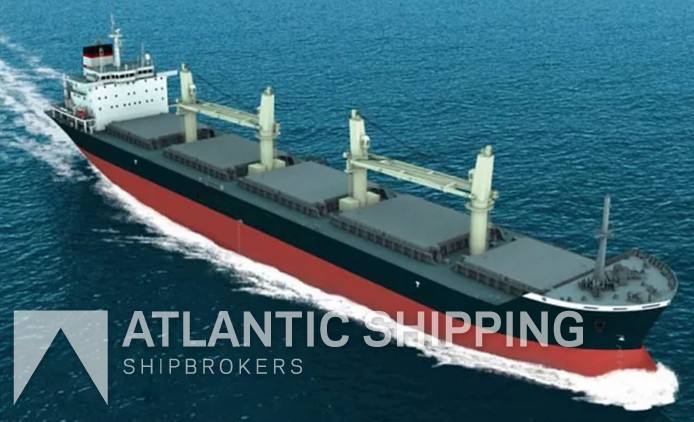The Purpose
and General Use of Seagoing Bulk Carriers
Numerous risks were encountered during the operation of seagoing bulk carriers. The safety of seagoing bulk carriers is a matter of meticulous preparation. This website will offer an immediate guideline to the global ship
ping community and information regarding loading and discharge of various bulk cargo kinds. It is important to remain
within the limitations set out by the classification
agency. It is essential to reduce the possibility of ship structure being stressed, and to follow all safety standards necessary for safe passage at Sea. We have detail pages that cover various topics related to bulk carriers. These are useful both for passengers onboard as well as those ashore in the terminal.
General characteristics of seagoing bulk vessels
Bulk carriers, or single-deck vessels equipped with top-side tanks or hopper side tanks in cargo spaces, are made to transport bulk cargo from a single commodity. Solid bulk cargo is any material other that gas or liquid, which is larger pieces of material,
generally well-composed, and loaded directly into the ship's cargo space. These dry cargoes include bulk grain, sugar, and ore. Bulk carriers can be defined as any ship that is designed to carry liquid or solid cargo in bulk. Tankers are also included. In normal usage, however the term is usually used to describe vessels that carry bulk cargoes consisting of solid items, such as grains and other agricultural commodities, as well as mineral items like coal ore, stone, or even coal in one or more journeys. Check out this
capesize bulk carrier blog for more.

What Is Bulk Carrier?
"A ship which is intended primarily to carry dry cargo in bulk, including such types as ore carriers and combination carriers"
Capacity to carry that ranges from 3,000 to 300,000.
Average speed of 12 to 15 knots
-Single deck ships, ie no tweendecks
Small to medium size bulk (carrying capacities between 40 and 60,000 tonnes) typically have equipment for handling cargo. However, larger vessels can use shore-based -facilities to load or unload.
Cargo holds that are big do not have obstructions, and are bigger hatch sizes for ease of loading/unloading.
Most bulk carriers have a cargo space dedicated to ballast. This is a possibility to use during ballast voyages to improve stability. A couple of additional holds could be allowed to ballast partially, but only when in port.
-They can be covered with single pull or hydraulic or stacking (piggyback) kind of steel hatch covers
Four kinds of ballast tanks :
Sloping topside wing tanks
Bottom of wing slopes downwards tanks
Double bottom tanks
After-peak and peak ballast water tank.
Bulk solid cargo? Anything that isn't liquids and gases, made up of particles, granules, or larger chunks of material. These items can be loaded directly into cargo spaces without the need for any other form of containment. The goods transported by bulk carriers, ranging from "clean" food items to "dirty" minerals and encompassing those that could react with each other or with contaminants like water, means that attention must be paid to ensure that the cargo areas are properly prepared for the specific item that is to be loaded. A surveyor will often be required to look over the area and determine if it's suitable to be loaded. To prevent contamination, it's essential to eliminate any remnants left from an earlier cargo. The damage to bulk cargoes is mainly caused by water. Therefore it is essential that not only the holds be dry to hold cargo, but the hatch covers must be watertight, or if necessary, sealed to prevent ingress of water. All fittings within the hold (ladders, pipe guards as well as bilge covers.) must be inspected to ensure they are in good shape and are securely installed. They could cause damages to conveyor belts and create delays. The ship may be held responsible if they were discharged accidentally with cargo. Check out this
ore carrier blog for more.

Bulk Carrier or Bulker? A vessel that is designed to transport dry cargo, loaded onto the vessel with no containment other than that of the vessel's boundaries and is distinct from the liquid bulk carrier or tanker. A traditional bulk carrier is equipped with a single deck, one skin, and a double bottom. It also contains topside tanks as well as cargo space tanks. Bulk carriers can carry any type or bulk cargo from heavy to light grain up to their maximum deadweight. It can be challenging to transport, load and discharge dry bulk cargo.
Carrier for bulk materials that does not require equipment
Certain bulk cargoes can be dangerous and may be damaged during passage.
Unintentional loading can result in damage to the ship, e.g. It is possible for a vessel to bow when it is not loaded properly. This is called stress. If the weather is bad the stress can result in dangerous problems on the sea. Last cargoes can be negatively impacted by residues of previous cargoes. Some bulk cargoes, such as cement power, can also suffer from water damage. cement power. It can be challenging to determine the true amounts and weights of the cargoes that are being loaded or not loaded. All these factors have serious implications for the safety of bulk cargoes. Discharging bulk cargo using? Bulk cargoes are able to be conical when they are loaded onto conveyor belts. This angle is called the "angle of repose" and is different based on each cargo. Iron ore cargoes, in contrast, form an angle that is steeply-angled. Cargoes whose flow is free will form cones that are shallower. Low angles of repose may cause cargo to shift during transit. When the cargo is nearing the point of completion, bulldozers may be necessary to spread the load across the hold. A lot of dry-bulk carriers rely on facilities at the shore for cargo discharge or loading. However bulk carriers could offer self-unloading with conveyors beneath the cargo holds or on decks.